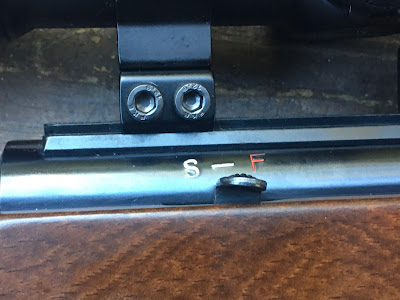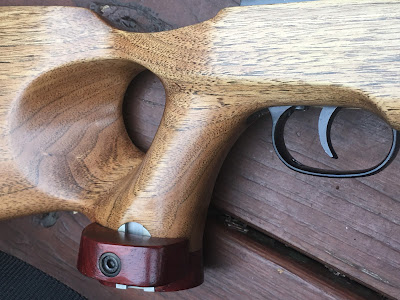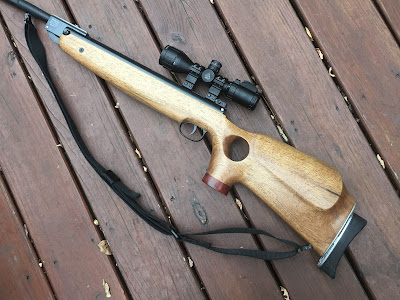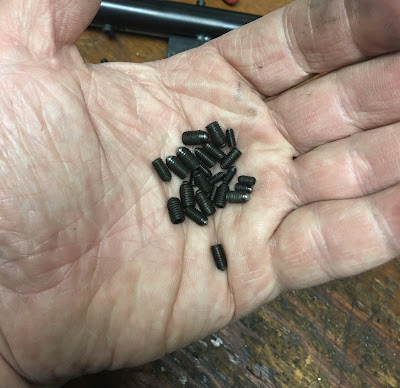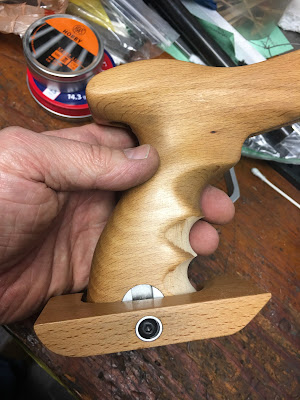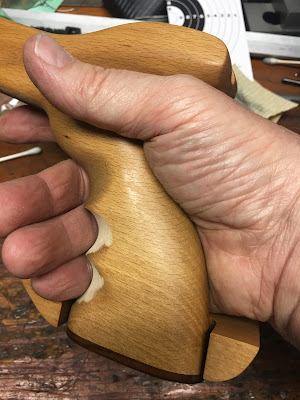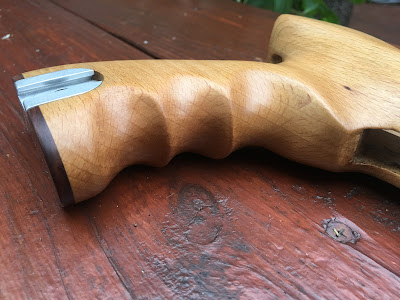Took a vacation last week. Cabin in the Smoky Mountains near Waynesville, NC. Between the hiking and raindrops, we found some time to do a little bit of air rifle shooting. Brought a rifle along that probably hasn't seen any screen time on this blog. It's an old Marksman Mod 56-FTS. The FTS stands for Field Target Special. The rifle was made in Germany by Weihrauch and it dates back to the late 1980's. Marksman also sold the similar Mod 58S geared toward silhouette shooting with a shorter barrel, full length barrel weight and non-adjustable stock.
The Marksman branded Weihrauchs always bring back good memories of my early airgunning. My first air rifle experience was a borrowed Marksman Mod 70 (a HW85) and that quality and accuracy made a huge impression.
The 80's were a long time ago and oddly enough, Marksman was selling this Model 56-FTS several years before Beeman started selling the almost identical R11 (HW98).
Looking through old issues of American Airgunner, I found a full-page ad inside the front cover for Marksman Mod 56-FTS in the July/August/September 1989 issue. Vol 4, No. 3. That puts the Marksman on the market about four years before the Beeman R11/HW98 hit the states.
The Beeman R11 --what we know today as the earliest version HW98-- appeared in the Beeman Precision Airgun Guide Edition #18 in 1993. Makes sense -- since SR Industries took over control of Beeman in April of 1993. The first version Beeman R11 blended the Marksman Mod 58S action --short barrel and full length barrel weight/sleeve--with the Mod 56's adjustable stock.
Here's a pic of the 56-FTS.
Seems like the rifle should've been much more popular. The stock is ambidextrous and the adjustability makes it easy to get a comfortable position.
Bought this rifle new from the now long gone Precision Airgun store in Maple Heights, OH. --And a trigger shoe and some sling mounts apparently. It was tuned before I started writing this blog with Nick. I may revisit the teardown as I don't recall any of the tune specifics. I don't know if I made a new spring guide, a top hat, rotation washers...
Side note: This is one of the airguns that Weihrauch made right after they acquired BSF (Bayerische Sportwaffenfabrik). I have no idea what Weihrauch got out of this deal. Machines? Workers? I always read about the guns being made "on BSF tooling" or something equally vague. If you look at the BSF offerings right before the acquisition, about the only thing carried over was the separate scope rail attachment. Oh yeah, some of the rifles (like the Marksman Mod. 70) got rear BSF sights. Stocks, barrels, and triggers all look like HW items. There WAS however a retooled trigger housing/carrier --from HW--that allowed them to use both their Perfekt and Rekord triggers on compression tubes that did not have threaded endcaps. The trigger components themselves were essentially unchanged.
So, I wonder if Weihrauch had originally intended to develop a separate line of air rifles and market them under the BSF name, but the Marksman deal came along and that name was chosen instead? Makes more sense to me than just "on BSF tooling".
Anyway, this is a HW Rekord trigger...
...with a very different safety. This one is on the right side of the gun (there are left side versions out there, too) The lever is fairly convenient. It automatically goes to "SAFE" when cocked, but unlike the standard HW button safety, this can be returned to "SAFE" after being moved to the "FIRE" position without re-cocking the barrel. However, due to a trigger blocking safety that engages when the rifle is broken open for cocking, the Marksmen rifles cannot be UN-COCKED.

Here's that BFS designed 11mm dovetail rail attached to the rear of the compression tube for scope mounting. I wish HW would've redesigned this rail and made it picatinny.
The 56/58 rifles had no provision at all for iron sights. Looks like I used some Sportsmatch scope rings along with a Leapers/UTG 4-16 scope.
Cheek piece is adjustable for height. The buttpad adjusts for height and rotation angle.

One of the only HW stocks I can think of that was stippled rather than checkered.
I replaced the forward stock screws with hex heads, but didn't make any screw cups at the time.
Originally, the Mod 56 was fitted with what we used to refer to as the "Crow Magnum Muzzle Brake"--or the 3-screw Beeman muzzle brake or something like that. Really, it's just a muzzle weight.
A couple years ago, I milled flats on the sides of my muzzle weight...
...and cut a radius down the top side with a ball shaped endmill before bead blasting and bluing. For, um, panache. If air rifles can have panache.
Those three screws.
I really like the lines of this modified barrel sleeve. Wanna look in the metal stockpile for a drawn over mandrel (DOM) tube that fits over the barrel and mill a full barrel length sleeve with the same profile.
And make some forend screw cups. Whatever I end up doing, it'll be a good excuse to spend some quality time with a Weihrauch--and that's always time well spent.
More soon.




